Thursday, April 29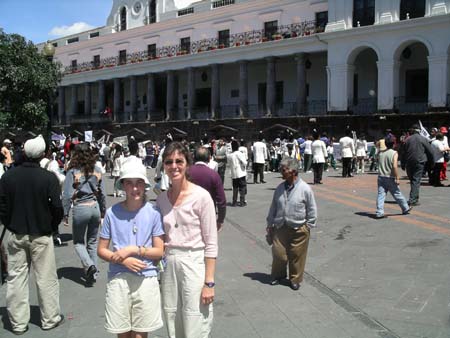
Paula: We have spent many nights in Quito, but had yet to actually
discover the city. So before heading to the Amazon tomorrow, we planned time
today to explore the capital city of Ecuador.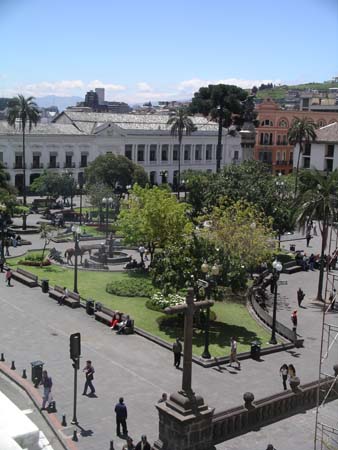
Quito has about 1.8 million residents and is composed of three distinct areas
- an old town, a new town and a southern section. The new town is complete
with the usual modern high rises, businesses and apartment buildings. The
old town is quite lovely and retains a traditional Spanish style. The southern
part of this city is home to 50% of Quito's residents, and is mostly a poorer
section of town.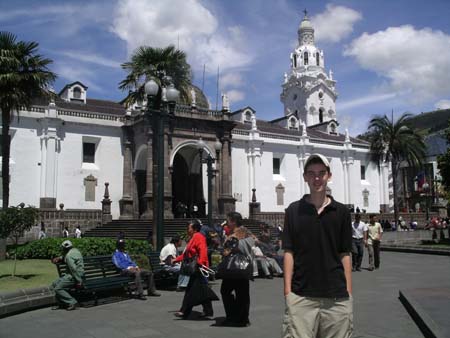
Quito has a long history. It was initially the capital of the Quito Empire
and was conquered in the 16th century by the Incas, becoming an important
commerce center for the Inca Empire until it was taken over by the Spanish
in 1535. While little remains from the Incas'  amazing
architecture, the Spanish heritage abounds. Independence Square is the center
of the city, framed by the Presidential Palace, the Metropolitan Cathedral
built in 1568, the City Hall and a lovely colonial building housing the mayor
and cardinals of Quito. The center of the square holds a memorial commemorating
the revolution in the early 1800's led by Antonio Sucre and Simon Bolivar.
amazing
architecture, the Spanish heritage abounds. Independence Square is the center
of the city, framed by the Presidential Palace, the Metropolitan Cathedral
built in 1568, the City Hall and a lovely colonial building housing the mayor
and cardinals of Quito. The center of the square holds a memorial commemorating
the revolution in the early 1800's led by Antonio Sucre and Simon Bolivar.
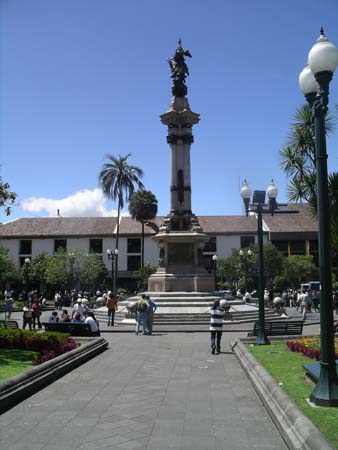
A peaceful demonstration filled the square today, as groups of school children were protesting the plan to move a prison into their neighborhood. We enjoyed walking through a monastery built in 1605 that currently houses the Metropolitan Center of Quito. We then walked to San Francisco Church, the oldest building and monastery in Quito dating from 1535. The traditional Spanish balconies, arches and columns along with colonial colors of yellow, white and blues make for a beautiful and peaceful city center.
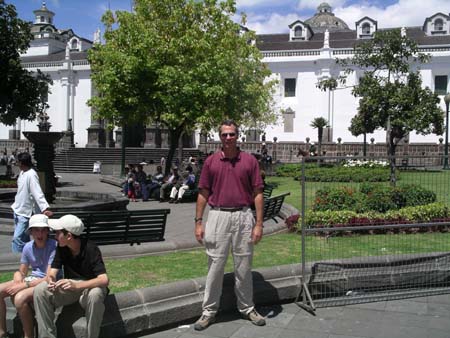 A
full 95% of Ecuadorians are Roman Catholic and the conversion of the Indians
to Christianity was facilitated by the location of the churches. The Incas
worshipped the Sun and the Spanish cleverly built the main cathedral in Quito
so that the position of the sun at the beginning of spring hit directly on
the face of Christ. This convinced the Incas that the two gods were one and
the same. As we saw in many cities in Europe, this city has many magnificent
churches and monasteries created by different orders of the Catholic Church,
all trying to outdo the other. In fact, Quito has 57 Catholic churches in
all.
A
full 95% of Ecuadorians are Roman Catholic and the conversion of the Indians
to Christianity was facilitated by the location of the churches. The Incas
worshipped the Sun and the Spanish cleverly built the main cathedral in Quito
so that the position of the sun at the beginning of spring hit directly on
the face of Christ. This convinced the Incas that the two gods were one and
the same. As we saw in many cities in Europe, this city has many magnificent
churches and monasteries created by different orders of the Catholic Church,
all trying to outdo the other. In fact, Quito has 57 Catholic churches in
all. 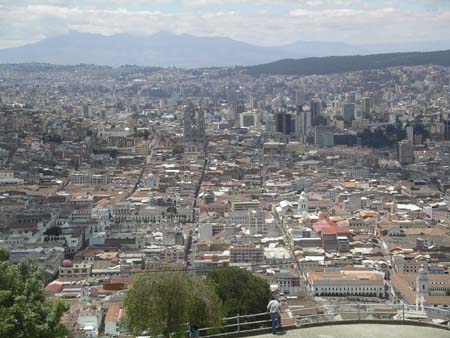
We enjoyed a wonderful view of the entire city on a hillside just outside the old town. Here a large statue of the Virgin Mary stands as a gift from Spain. From this location, we were able to see the four volcanoes that surround Quito, some as high as 18,000 feet above sea level. The southern part of the city is also visible from this point and it was obvious that many of the residents live in this poorer section of the city. Over 50% of Quito's residents make less than $130/month. Fortunately, they have been provided affordable housing and homelessness is not as much of an issue here as it is in many other South American cities.
We enjoyed one last dinner here in Quito before beginning our adventure in the Amazon Rainforest tomorrow morning. We will be staying at the Kapawi eco-lodge, accessible only by a 1 ½ hour flight in a small aircraft, followed by a 1 ½ hour trip in a motorized canoe. It will be a few days before we will be able to be in touch again, but are sure to have more interesting stories to tell.
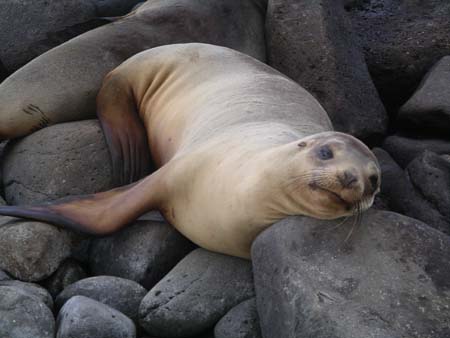
Katie's Kwick Kwacks: My Impressions of the Galapagos Islands. I reluctantly poked my head out of the water. "It's time to go," shouted one of the naturalist guides. I didn't want to. I was in the middle of a group of 15 magnificent sea lions. After taking one last look at the group, I turned to get back on the zodiac. I was about to grab hold of the ladder when a medium sized sea lion appeared between me and the boat. He swam to me on his back with a pleading and somber look on his face. Our noses joined together. I'll never forget the life in that creature's eyes. I quickly turned my head to see if anyone saw us. When I turned back it was gone.
The Galapagos is surely one of the most amazing places we've been on the trip. It perhaps the best place in the world to actively view nature in progress. This is a truly incredible experience, one that I can't imagine living without. Do whatever you want: read books, watch movies, anything. There is nothing like actually going there and fully experiencing progressive evolution. To actually be able to see these evolved creatures is enough to satisfy anyone, but this was just the basis of what we actually witnessed here on the islands. The remarkable thing about this place is that you have the ability to not only see the wildlife, but also be a part of it. Because the animals are so tame, we had the opportunity to get close and observe their behaviors without feeling like we were intruding. In other words we were a part of the "living science" on the Galapagos Islands. The following paragraphs describe some of my most memorable experiences in this extraordinary place.
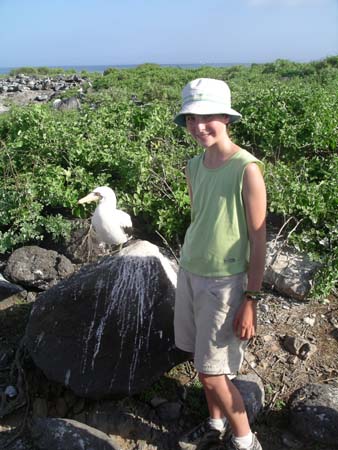 I'll
begin by talking about some of my favorite experiences with marine life here.
One of these was when I was able to swim right beside a giant sea turtle the
size of my own body. I was swimming inches away from him, and it didn't even
seem to notice me. I wasn't just able to watch this turtle live in his natural
environment; I was able to be in it with him. We have had countless experiences
like this throughout our stay in the archipelago.
I'll
begin by talking about some of my favorite experiences with marine life here.
One of these was when I was able to swim right beside a giant sea turtle the
size of my own body. I was swimming inches away from him, and it didn't even
seem to notice me. I wasn't just able to watch this turtle live in his natural
environment; I was able to be in it with him. We have had countless experiences
like this throughout our stay in the archipelago.
Another memorable experience I had is when I got to watch a penguin feeding underwater. Once again it was not only watching the penguin that made it special, but more remarkably, being with it. I was literally in the middle of the scene when I saw a little penguin dart after the school of fish I was in. One other neat experience I had in the water is swimming with the sea lion families on our last day. These animals not only allowed us to swim with them, they actually really enjoyed our company. It was incredible to play around with them-it was like a big sea world zoo where they train the animals to do tricks for you. The difference is that this was real. It was in their natural habitat. They didn't do it to get a treat afterwards…they did it to have fun.
After a while I began to feel more comfortable when they went right up to
my mask, splashed me with their flippers, and tried to scare me by jumping
right in front of my face or over my head-I learned to play right back. When
I stepped out of the water and saw their begging faces, I wanted to jump right
back in again-I could have spent several more hours with them. The sea lions
enjoyed it as much as we did, and it was great to know that we could make
their day while still having the time of our lives. 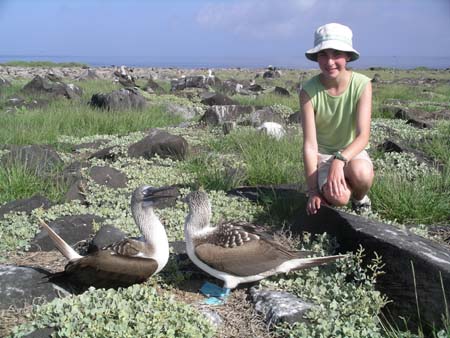
Another equally wonderful part of our trip to the Galapagos was seeing and witnessing all of the life on land. I'll begin by discussing some of my favorite experiences with the bird life here. Never in my life have I seen birds so interesting and active as the ones we saw in the Galapagos. My favorite was the blue-footed booby. I am so pleased that we were able to see them during the fascinating months of the mating season. It was truly amazing to walk through a field of these birds, watching and listening as they performed their long courtship dance. We were able to get inches away from couples as they talked and danced-an experience I will never forget.
It was also incredible to see the boobies nesting on our last day. This last excursion allowed us to see the complete process of courtship, mating, nesting, and hatching. I will never forget the moment the little head of that chick poked up from underneath the mother's chest. I will also never forget watching over twenty boobies dive into the water at the same time at the harbor in Santa Cruz. It was a great ending to our encounters with these birds. I enjoyed watching the male frigate birds puff up their red pouches, spread out their wings, and shake and gobble like crazy when a female flew over head. I loved watching the cormorants dry their stubby wings in the sun, and admiring the swallow-tailed gulls' striking red eyes …I could go on and on. All of the birds are so unique, and I was fascinated by every one.
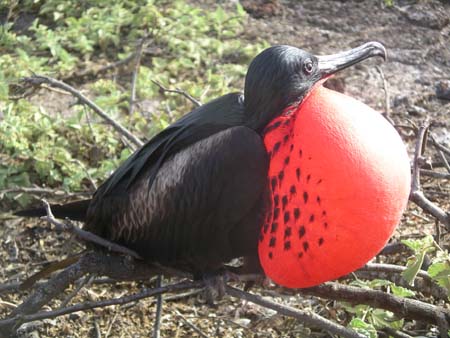
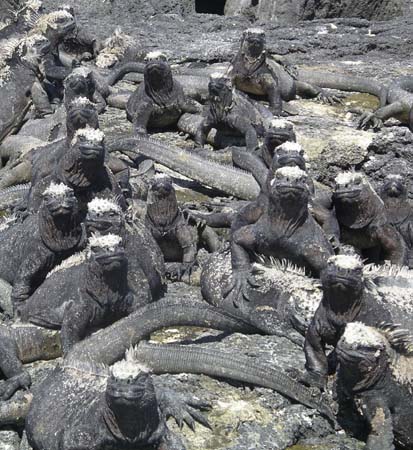 I
have also had some great memories with other land creatures on the Galapagos.
Some of my other favorite land animals include iguanas, tortoises, and Sally
lightfoot crabs. I'll start by talking about what I thought about the iguanas
and lizards on the archipelago. At first sight, everything on the islands
seems to be so dry, desolate, and lifeless. You walk across ancient black
lava flows with hardly any bushes or plant life growing between them. If you
begin to observe more closely, however, you will begin to hear little organisms
scurrying across the ground. These are known as "lava lizards."
Now aware of these new forms of life, you begin to notice more and more of
these creatures scampering across the streams of volcanic material. You start
looking around. Everything is quiet and mysterious…motionless. When you
begin to look more closely at the lava rocks by the shore, however, you notice
some imperfect bumps in the middle of these flows. There are lots and lots
of them. You then make out their forms-they're marine iguanas. They are all
packed together in sturdy poses, facing the sun. It is a truly fantastic sight.
It is incredible to think that in a place so deserted, isolated, and untouched
there is still a remarkable sense of wonder and life. It's like being on an
alien inhabited moon.
I
have also had some great memories with other land creatures on the Galapagos.
Some of my other favorite land animals include iguanas, tortoises, and Sally
lightfoot crabs. I'll start by talking about what I thought about the iguanas
and lizards on the archipelago. At first sight, everything on the islands
seems to be so dry, desolate, and lifeless. You walk across ancient black
lava flows with hardly any bushes or plant life growing between them. If you
begin to observe more closely, however, you will begin to hear little organisms
scurrying across the ground. These are known as "lava lizards."
Now aware of these new forms of life, you begin to notice more and more of
these creatures scampering across the streams of volcanic material. You start
looking around. Everything is quiet and mysterious…motionless. When you
begin to look more closely at the lava rocks by the shore, however, you notice
some imperfect bumps in the middle of these flows. There are lots and lots
of them. You then make out their forms-they're marine iguanas. They are all
packed together in sturdy poses, facing the sun. It is a truly fantastic sight.
It is incredible to think that in a place so deserted, isolated, and untouched
there is still a remarkable sense of wonder and life. It's like being on an
alien inhabited moon.
I also enjoyed seeing giant tortoises in the wild. It s amazing to watch
them heaving as their feet struggle to move under their body's enormous weight.
In addition, I enjoyed seeing the well-known Sally lightfoot crabs. We watched
in fascination as these crabs gathered by the ocean, forming red dots all
over the rocks. I loved seeing them all use their tiny legs to quickly scurry
back when a wave came. All of these animals are so interesting, and despite
their many differences, seem to live in remote harmony with one another-the boobies dive together, the crabs gather together,
and the iguanas pile up on one another.
harmony with one another-the boobies dive together, the crabs gather together,
and the iguanas pile up on one another.
With all of these incredible experiences you're probably wondering how I can really summarize all that we've done here. After spending a week on the archipelago, I believe the most remarkable thing about this adventure is not how much I've seen and experienced, but instead how much I have learned about the role of science in the world. The islands have been eye openers not only because of how amazing all the things here are-they have also opened my mind to the fact that science, evolution and changes are happening all around us. I have realized that the Galapagos Islands are not the only place in the world where evolution occurs-they are special because they're one of the few places where this process is visible. By comparing the Galapagos species with species in the South American mainland and the rest of the world, we are able to identify the evolutionary changes that have occurred here in the recent past.

The Galapagos Islands are an amazing place, and they need help to preserve their many mysteries and wonders. Witnessing all I have discussed in this essay has motivated me to try and contribute to the conservation of the islands and their species. I think that everyone in this world has the right to come here, and if we don't start acting quickly the next generation may not be able to see what my family has in the past week. To be part of the living science of the Galapagos Islands is an experience that I will treasure and retell for the rest of my life.
